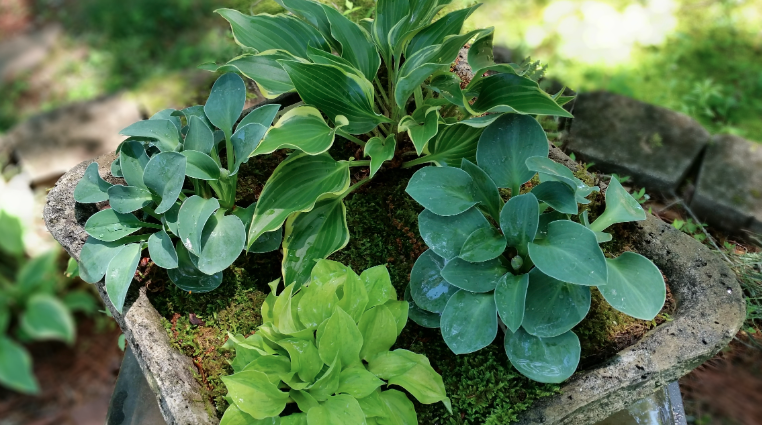There's a lot to love about hostas. They offer gorgeous foliage, are easy to grow and low-maintenance, and come in a wide variety of colors, shapes, and sizes. Hostas are also perfect for container planting.
Larger hostas are perfect for large statement planters. Mini and small hostas make cute plantings on their own or are great for fairy gardens and companion planting with other attractive shade plants like heuchera.
With just a little water and maintenance, container-grown hostas will provide beauty to your shady areas for years to come.
Why Grow Hostas in Containers
- You can bring lush foliage to your porch or patio.
- Mini hostas are excellent additions to fairy gardens.
- You can move hostas in containers as needed.
- You don't need a big backyard; planters can allow you to grow hostas in a small space.
- Mini Hostas are excellent for combining with other shade-tolerant plants to create interesting containers.
- Hostas are perennials, so your container plantings will look great for years. You just have to refresh the soil every few years if compacted.
Choosing a Variety
Any hosta, mini to giant, can be grown in a container. Some of our favorites include:
- Dragon Tails
- Munchkin Fire
- Baby Blue Eyes
- Cookie Crumbs
- Curly Fries
- Baby Booties
- First Frost (large container)
- Autumn Frost (large container)
- Island Breeze (large container)
Selecting a Container
The most important thing when selecting a container is drainage. You'll want a container that has drainage holes or one where you can add them yourself. Other than that, plastic, ceramic, metal, terracotta, and wood planters all work for hostas. It can be fun to repurpose containers out of found objects.
You should also consider how big your hosta will be at maturity. Mini and small hostas can be grown alone in small pots, or you can use several varieties and even other shade-loving plants to create stunning combinations in container or fairy gardens. Medium and large hostas can also be grown in pots but require a much larger container.
Soil
When you're going in pots, you need to use potting soil, not regular garden soil. Potting soil is designed to drain well and compact less, making it easy for the roots to grow. In large containers, you can add a bit of bark or perlite to the mix.

Planting
Planting in a container is just like planting a hosta in the ground. Place your hosta in a hole so that the clump is level with the top of the soil. Then gently pack the soil in around the roots. Water your hosta thoroughly after planting.
You may want to add a bit of slow-release fertilizer after planting. We use Osmocote fertilizer with an NPK (nitrogen-phosphorus-potassium) ratio of 15-9-2. Hostas aren't that picky. You can use other hosta fertilizers as well. Follow package instructions for application rates and avoid putting fertilizer directly onto hosta crowns, shoots, and leaves as this can burn the plant.
Once you've planted your hostas, move your containers to an area that receives filtered light. Hosta leaves will burn in full sun.
Maintenance
Hostas do best with consistent moisture. Container plantings tend to dry out much faster than garden plantings, so it's essential to stay on top of watering, especially during hot and dry weather.
Each spring, you can give your containers a little refresh by adding a bit of soil to the pot. You can also provide a bit of fertilizer each spring.
Hostas are quite cold tolerant and shouldn't require any additional winter protection as long as your pot has proper drainage.
Repotting
You should plan on needing to repot your hostas every two to three years. Potting soil becomes compacted and loses porosity and nutrients over time. Repotting your hostas provides fresh nutrients and allows proper water and airflow to the roots.
Hostas are easy and fun to grow. They provide a stunningly wide variety of foliage and flowers perfect for shady areas around your home and yard. Using these tips, you can successfully grow hostas in containers, whether you choose a fairy garden full of tiny hostas or a large pot with one of our giant cultivars.

